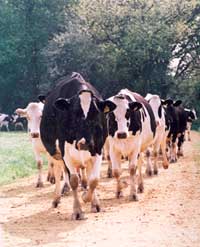Cow tracks need regular maintenance

To reduce winter housing costs, farmers should be thinking now about how they are going to get cows out to grass next season, according to Jo Speed, DairyCo extension officer.
“When you want to get cows out early next year, it is well worth either maintaining or installing cow tracks,” she said.
“All tracks need a minimum of annual maintenance – dirt and limestone tracks should be consolidated with an industrial vibrating roller and bark walk ways, topped up.
“You can’t expect existing tracks to look after themselves, you might as well pour money down the drain.”
Those considering installing new tracks should look local for supplies, with builders’ rubble offering a good option for track bases. Concrete sleepers can also be easily laid and moved.
“It is also important to think about where water is going and the camber and drainage at the edge of a track – a track can be ruined by a season of heavy rain.”
However, even when tracks are addressed, gateways can still be a limiting factor to getting cows out. “Consider installing multiple gateways to take the pressure off,” she said.
And when considering where to position tracks, it is important to think outside of the box. “It may be that a track should run straight though the middle of a field.
“Look at a map of the farm and assess infrastructure. Identify which fields you are anticipating using for late and early grazing – when you don’t do so, you could be missing a trick.
“When you address both tracks and gateways, there is the potential to extend the grazing season by 4-6 weeks at either end.”
But to ensure grass is ready for stock to go out early in the spring, grass must be left in the right condition over winter, said Barry Ward, national sales manager for The Livestock Improvement Company.
“You should be leaving paddocks with a residual of 2300kg DM/ha after autumn grazing and not grazed with sheep over winter.”
And by getting cows on to grass in February, grass production can be given a good start for the rest of the growing season.
“By grazing in February, you can double grass production – so a field may be producing 5kg DM/ha, but by grazing cows this could increase to 10kg DM/ha.”
But to avoid poaching at this time of year, it may be worth putting cows out for short periods of three hours, he said.
A few people can’t graze in February, but most can, said Piers Badnell, DairyCo extension officer.
“Walk your fields in January and February – you may be surprised that you will be able to get cows out.”
“Put your low yielders out and get a few kilos of dry matter from grass. This may only constitute 5kg dry matter a cow a day in February, but it will train your cows up for later in the season and get the grass wedge going.”
But when it is not possible to get cows out until April, it is important to bear in mind the fact grass will be growing from February. “This could mean that grass gets ahead. To get over this, sheep could be used to graze over winter, but this must be planned.”
